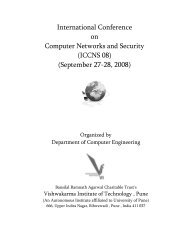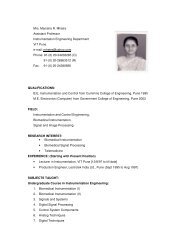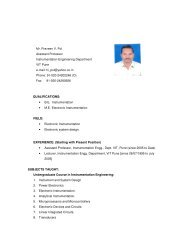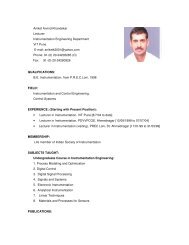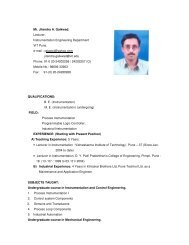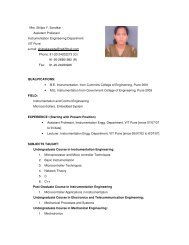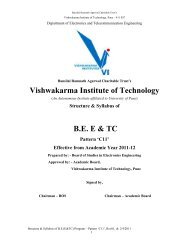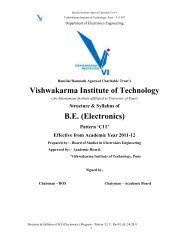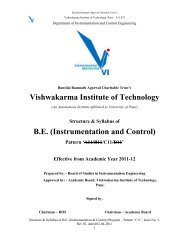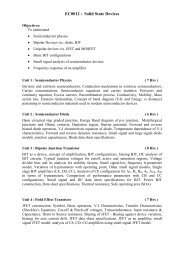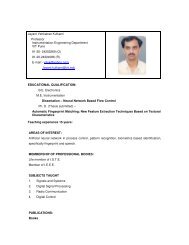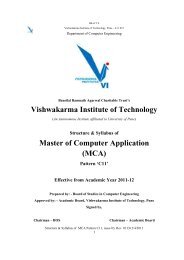mechb11m8 - Vishwakarma Institute of Technology
mechb11m8 - Vishwakarma Institute of Technology
mechb11m8 - Vishwakarma Institute of Technology
Create successful ePaper yourself
Turn your PDF publications into a flip-book with our unique Google optimized e-Paper software.
BRACT’S<strong>Vishwakarma</strong> <strong>Institute</strong> <strong>of</strong> <strong>Technology</strong>, Pune – 411 037Department <strong>of</strong> Mechanical EngineeringContentSr. SubjectTitlePageNo. CodeNo.1 Program Educational Objectives <strong>of</strong> B.E. ( Mechanical6Engineering)2 Course Structure - Module III 93 Course Syllabi for courses - Module III3.1 ME21101 Mathematics 103.2 ME20103 Kinematics and Mechanisms 123.3 ME20105 Machine Drawing Computer Aided Drafting 143.4 ME20107 Metallurgy and Material Science 163.5 ME20201 Mathematics 183.6 ME20203 Kinematics and Mechanisms 193.7 ME20305 Machine Drawing Computer aided Drafting 213.8 ME20307 Metallurgy and Material Science 233.9 ME24401 Mini Project 243.10 ME24301 Workshop Practice 243.11 @ Elective –S<strong>of</strong>t Skills3.12 ME20401 $ Comprehensive Viva Voce3.13 @ <strong>Institute</strong> Elective4 Course Structure - Module IV 275 Course Syllabi for courses - Module IV5.1 ME20102 Strength <strong>of</strong> Machine Elements 285.2 ME20104 Mechanical Design 305.3 ME20106 Thermal Engineering 335.4 ME20108 Fluid Mechanics 355.5 ME20202 Strength <strong>of</strong> Machine Elements 375.6 ME20204 Mechanical Design 385.7 ME20306 Thermal Engineering 395.8 ME20308 Fluid Mechanics 405.9 ME24402 Mini Project 415.10 ME24302 Creativity and Project Development 425.11 @ Energy Audit5.12 ME20402 $ Comprehensive Viva Voce5.13 @ <strong>Institute</strong> Elective6 Course Structure - Module V 457 Course Syllabi for courses - Module V7.1 ME31101 Manufacturing Techniques 46Structure and Syllabus <strong>of</strong> B.E. (Mech), Pattern ‘B11’, Issue 3, Rev 1, dated 02/04/20112
BRACT’S<strong>Vishwakarma</strong> <strong>Institute</strong> <strong>of</strong> <strong>Technology</strong>, Pune – 411 037Department <strong>of</strong> Mechanical Engineering7.2 ME30103 Design <strong>of</strong> Machine Elements 487.3 ME30105 Metrology and Measurement Techniques 517.4 ME30107 Heat Transfer 537.5 ME31201 Manufacturing Techniques 567.6 ME30203 Design <strong>of</strong> Machine Elements 577.7 ME30305 Metrology and Measurement Techniques 587.8 ME30307 Heat Transfer 607.9 ME34401 Mini Project 617.10 @ <strong>Institute</strong> Level7.11 ME30403 $ Comprehensive Viva Voce7.12 ME37301 $ Seminar8 Course Structure - Module VI 649 Course Syllabi for courses - Module VI9.1 ME30102 Theory <strong>of</strong> Machines 659.2 ME30104 Internal Combustion Engines 679.3 ME30106 Fluid Machinery and Fluid Power Engineering 709.4 ME30108 Computational Methods in Mechanical engineering 729.5 ME30202 Theory <strong>of</strong> Machines 749.6 ME30204 Internal Combustion Engines 769.7 ME30306 Fluid Machinery and Fluid Power Engineering 779.8 ME30308 Computational Methods in Mechanical engineering 789.9 @ <strong>Institute</strong> Level9.10 ME30404 $ Comprehensive Viva Voce9.11 ME37302 Project Stage I 8010 Course Structure - Module VII 8311 Course Syllabi for courses - Module VIIElective Group I11.1a ME42101 Kinematic Analysis & Synthesis 8411.1b ME42103 Tribology 8611.1c ME42105 Design <strong>of</strong> Composite Materials 8811.1d ME42107 Machine Tool Design 90Elective Group II11.2a ME42109 Heat Exchange Devices 9211.2b ME42111 Turbo machines 9411.2c ME42113 Thermal Power Plants 9611.2d ME42115 Energy Conservation And Management 9811.3 ME40101 Design <strong>of</strong> Mechanical Systems 10011.4 ME40103 CAD/CAM/CAE 103Elective Group I11.5a ME42201 Kinematic Analysis & Synthesis 106Structure and Syllabus <strong>of</strong> B.E. (Mech), Pattern ‘B11’, Issue 3, Rev 1, dated 02/04/20113
BRACT’S<strong>Vishwakarma</strong> <strong>Institute</strong> <strong>of</strong> <strong>Technology</strong>, Pune – 411 037Department <strong>of</strong> Mechanical Engineering11.5b ME42203 Tribology 10611.5c ME42205 Design <strong>of</strong> Composite Materials 10711.5d ME42207 Machine Tool Design 107Elective Group II11.6a ME42209 Heat Exchange Devices 10811.6b ME42211 Turbo machines 10911.6c ME42213 Thermal Power Plants 11011.6d ME42215 Energy Conservation And Management 11211.7 ME40301 Design <strong>of</strong> Mechanical Systems 11311.8 ME40303 CAD/CAM/CAE 11511.9 ME47303 Project Stage II 11712 Course Structure - Module VIII 11913 Course Syllabi for courses - Module VIIIElective Group III13.1a ME42102 Finite Element Method 12013.1b ME42104 Optimization Techniques 12213.1c ME42106 Reverse Engineering and Rapid Prototyping 12413.1d ME42108 Simulation <strong>of</strong> Mechanical Systems 126Elective Group IV13.2a ME42110 Robotics 12813.2b ME42112 Mechatronics 13013.2c ME42114 Operation Research 13213.2d ME42116 Instrumentation and Automatic Controls 13413.3 ME40106 Vibration Analysis 13613.4 ME40108 Refrigeration and Air-conditioning 138Elective Group III13.5a ME42202 Finite Element Method 14013.5b ME42204 Optimization Techniques 14213.5c ME42206 Reverse Engineering and Rapid Prototyping 14313.5d ME42208 Simulation <strong>of</strong> Mechanical Systems 144Elective Group IV13.6a ME42210 Robotics 14513.6b ME42212 Mechatronics 14613.6c ME42214 Operation Research 14713.6d ME42216 Instrumentation and Automatic Controls 14813.7 ME40306 Vibration Analysis 14913.8 ME40308 Refrigeration and Air-conditioning 15013.9 ME47304 Project Stage III 15114 Course Structure for Honors in B.E. ( MechanicalEngineering)15 Course Syllabi for courses <strong>of</strong>fered as HonorsStructure and Syllabus <strong>of</strong> B.E. (Mech), Pattern ‘B11’, Issue 3, Rev 1, dated 02/04/20114
BRACT’S<strong>Vishwakarma</strong> <strong>Institute</strong> <strong>of</strong> <strong>Technology</strong>, Pune – 411 037Department <strong>of</strong> Mechanical EngineeringProgram Educational Objectives (PEO)B.E. (Mechanical Engineering)PEO No.123456789Description <strong>of</strong> the ObjectiveGraduates will demonstrate basic knowledge in mathematics, science andengineering.Graduates will demonstrate the ability to design and conduct experiments,interpret and analyze data, and report results.Graduates will demonstrate the ability to design a mechanical system or a thermalsystem or a process that meets desired specifications and requirements.Graduates will demonstrate the ability to function on engineering and sciencelaboratory teams, as well as on multidisciplinary design teams.Graduates will demonstrate the ability to identify, formulate and solve mechanicalengineering problems.Graduates will demonstrate an understanding <strong>of</strong> their pr<strong>of</strong>essional and ethicalresponsibilities.Graduates will be able to communicate effectively in both verbal and writtenforms.Graduates will have the confidence to apply engineering solutions in global andsocietal contexts.Graduates should be capable <strong>of</strong> self-education and clearly understand the value <strong>of</strong>lifelong learning.10Graduates will be broadly educated and will have an understanding <strong>of</strong> the impact<strong>of</strong> Engineering on society and demonstrate awareness <strong>of</strong> contemporary issues.6Structure and Syllabus <strong>of</strong> B.E. (Mech), Pattern ‘B11’, Issue 3, Rev 1, dated 02/04/2011
BRACT’S<strong>Vishwakarma</strong> <strong>Institute</strong> <strong>of</strong> <strong>Technology</strong>, Pune – 411 037Department <strong>of</strong> Mechanical Engineering11Graduates will be familiar with modern engineering s<strong>of</strong>tware tools and equipmentto analyze mechanical engineering problems.7Structure and Syllabus <strong>of</strong> B.E. (Mech), Pattern ‘B11’, Issue 3, Rev 1, dated 02/04/2011
BRACT’S<strong>Vishwakarma</strong> <strong>Institute</strong> <strong>of</strong> <strong>Technology</strong>, Pune – 411 037Department <strong>of</strong> Mechanical EngineeringMODULE VIIIStructure and Syllabus <strong>of</strong> B.E. (Mech), Pattern ‘A11’, Issue 3, Rev 1, dated 02/04/2011119
BRACT’S<strong>Vishwakarma</strong> <strong>Institute</strong> <strong>of</strong> <strong>Technology</strong>, Pune – 411 037Department <strong>of</strong> Mechanical EngineeringSTRUCTURE MODULE VIIISubjectNo.S5S6SubjectCodeME42102ME42104ME42106ME42108ME42110ME42112ME42114ME42116Subject Name*Elective Group IIIFinite Element MethodOptimization TechniquesReverse Engineering andRapid PrototypingSimulation <strong>of</strong>Mechanical Systems**Elective Group IVRoboticsMechatronicsOperation ResearchInstrumentation andAutomatic ControlsTeaching Scheme(Hrs/week)LectTutorial.PracticalCredits3 0 0 33 0 0 3S7 ME40106 Vibration Analysis 3 0 0 3S8Refrigeration and AirconditioningME40108 3 0 0 3T3*Elective Group IIIFinite Element MethodME42202 Optimization TechniquesME42204 Reverse Engineering andME42206 Rapid PrototypingME42208 Simulation <strong>of</strong>Mechanical Systems0 1 0 1T4ME42210ME42212ME42214ME42216**Elective Group IVRoboticsMechatronicsOperation ResearchInstrumentation andAutomatic Controls0 1 0 1P3 ME40306 Vibration Analysis 0 0 2 1P4Refrigeration and AirconditioningME40308 0 0 2 1PS3Stage III (Irrespective <strong>of</strong>ME47304Module)0 0 8 6Total 12 2 12 22Structure and Syllabus <strong>of</strong> B.E. (Mech), Pattern ‘A11’, Issue 3, Rev 1, dated 02/04/2011120
BRACT’S<strong>Vishwakarma</strong> <strong>Institute</strong> <strong>of</strong> <strong>Technology</strong>, Pune – 411 037Department <strong>of</strong> Mechanical EngineeringME42102 :: FINITE ELEMENT METHODCredits: 03Teaching Scheme: - Theory 3 Hrs/WeekPrerequisites: NilObjectives:• To create an environment for the students to learn the mathematical background <strong>of</strong>the Finite Element Method (FEM)• Use the method to solve 1D and 2D problems.• Understand steps involved in the solution <strong>of</strong> a problem using FEA s<strong>of</strong>tware.• To develop capabilities <strong>of</strong> using existing commercial FEM s<strong>of</strong>tware.Unit IFundamental Concepts(8 Hrs)A. Stresses and equilibrium, boundary conditions, strain displacement relation,temperature effect, potential energy and equilibrium, Galerkin’s method, Integralformulation for Numerical Solution-Variational method, Collocation method, Galerkin’smethod.B. Saint Venant’s principle, Von Mises stress, Gaussian Elimination, Stress and strainrelations, plane stress and plain strain, Potential energy method.Unit IIOne Dimensional Problems(8 Hrs)A. Linear element, Solution by Galerkin’s method, solution for nodal residual equation,Obtaining elemental stiffness and load matrices form the above equation. Assembly <strong>of</strong>the above matrices for obtaining Global stiffness and Load matrix.Application <strong>of</strong> the above equation for Problems like, Beam Analysis, temperaturedistribution analysis, Voltage distribution analysis, etc.B. Quadratic shape functions.Unit IIITwo Dimensional Finite Elements(8 Hrs)A. Linear triangular and Bilinear Rectangular elements, Shape function for the same.Local co-ordinate system, significance <strong>of</strong> natural co-ordinate system, Natural co-ordinatesystems for linear element, Linear Triangular element.B. Local co-ordinate system for Bilinear Rectangular elements.Structure and Syllabus <strong>of</strong> B.E. (Mech), Pattern ‘A11’, Issue 3, Rev 1, dated 02/04/2011121
Unit IVTwo Dimensional FEA ModellingBRACT’S<strong>Vishwakarma</strong> <strong>Institute</strong> <strong>of</strong> <strong>Technology</strong>, Pune – 411 037Department <strong>of</strong> Mechanical Engineering(8 Hrs)A. FEA modeling, Const. strain triangles-Isoperimetric representation, potential energymethod, stiffness and force terms, stress calculations, temperature effect. Problemmodeling and boundary conditions.B. Application <strong>of</strong> the above equation to Torsion <strong>of</strong> Non Circular cross section,Electromagnetic static FEA for finding magnetic flux density in air gap.Unit VTwo Dimensional FEA Applications(8 Hrs)A. Differential equation for Axisymmetric field problems, solution by Galerkin’s method,obtaining elemental stiffness and load matrices. Problems by using triangular elements.Quadratic Shape functions.B. One case study on Axisymmetric FEAText Books1. “Applied Finite Element Analysis”, Segerlind L. J., John Wiley and Sons New York.2. “Concepts and Applications <strong>of</strong> Finite Element Analysis”, Cook R D., Malkus D. S.and Plesha M. E., New York. John Wiley and Sons.3. “Textbook Of Finite Element Analysis”, Seshu P., New Delhi. Prentice Hall <strong>of</strong> India.Reference Books1. “Theory and Problems <strong>of</strong> Finite Element Analysis”, Buchanan G. R., Mcgraw HillInc. New York, 1994.2. “Finite Element Method-Linear Static and Dynamic Finite Element Analysis”,Hughes Thomas J., New York. Dover Pub., 20073. “Finite Element Analysis-thermo mechanics <strong>of</strong> solids”, Nicholson David W: NewYork. CRC Press, 2003.Additional Reading1. “Finite Element Analysis in Engineering Design”, Rajasekaran S., WheelerPublication, Allahabad.2. “Schaum's Otlines Finite Element analysis”, Buchanan George R., New Delhi. TataMc Graw Hill Publication Co.3. “Fundamentals <strong>of</strong> Finite Element Analysis”, Hutton David V., New Delhi. TataMcgraw-Hill Publishing Company Ltd.Structure and Syllabus <strong>of</strong> B.E. (Mech), Pattern ‘A11’, Issue 3, Rev 1, dated 02/04/2011122
BRACT’S<strong>Vishwakarma</strong> <strong>Institute</strong> <strong>of</strong> <strong>Technology</strong>, Pune – 411 037Department <strong>of</strong> Mechanical EngineeringME42104 :: OPTIMIZATION TECHNIQUESCredits: 03Teaching Scheme: - Theory 3 Hrs/WeekPrerequisites:•Preferred:•Objectives:•Unit IOne-Dimensional OptimizationInterval halving, Fibonacci, golden search method.(8 Hrs)Unit IITwo-Dimensional Optimization(8 Hrs)Two-dimensional optimization Gradient based methods: conjugate gradient, steepestdescent, examples.Unit IIILinear ProgrammingModel formation, graphical, simplex, dual simplex.Unit IVConstrained OptimizationLagrange multipliers, Direct Search Method, linearization methods.Unit VIntroduction to Evolutionary AlgorithmsGenetic algorithm, Fuzzy logic, Neural network.(8 Hrs)(8 Hrs)(8 Hrs)Unit VI(Self Study)Review <strong>of</strong> Mathematics, calculus, linear algebra, function <strong>of</strong> several variables, extrema,and constrained extrema.Structure and Syllabus <strong>of</strong> B.E. (Mech), Pattern ‘A11’, Issue 3, Rev 1, dated 02/04/2011123
BRACT’S<strong>Vishwakarma</strong> <strong>Institute</strong> <strong>of</strong> <strong>Technology</strong>, Pune – 411 037Department <strong>of</strong> Mechanical EngineeringText Books1. “Optimization: Theory and Practice”, Mohan Joshi and Kannan Moudgalya,Narosa Publishing House, Bombay.2. “Optimization: concepts and application engineering”, Ashok Belegundu andTirupathi Chandrupatla, Pearson Education Asia, Delhi.3. “Engineering Optimization”, Singiresu S. Rao, New Age International (P) Ltd.,Bombay.Reference Books1. “Neural Networks, Fuzzy Logic, and Genetic Algorithms: Synthesis andApplications”, Rajasekaran G., G. A. Vijaylakshmi Pai, PHI.2. “Operations Research: Applications and Algorithms”, Winston W. L., DuxburyPress.3. “Methods <strong>of</strong> Optimization”, Walsh G. R.., Wiley.Structure and Syllabus <strong>of</strong> B.E. (Mech), Pattern ‘A11’, Issue 3, Rev 1, dated 02/04/2011124
BRACT’S<strong>Vishwakarma</strong> <strong>Institute</strong> <strong>of</strong> <strong>Technology</strong>, Pune – 411 037Department <strong>of</strong> Mechanical EngineeringME42106 :: REVERSE ENGINEERING AND RAPIDPROTOTYPINGCredits: 03Teaching Scheme: - Theory 3 Hrs/WeekPrerequisites:•Preferred:•Objectives:•Unit IIntroduction to Rapid Prototyping(7 Hrs)Prototype Fundamentals, Historical Development, Fundamentals <strong>of</strong> Rapid Prototyping,Advantages <strong>of</strong> Rapid Prototyping, Commonly Used Terms, Classifications <strong>of</strong> RapidPrototyping System.Rapid Prototyping Process Chain: Process Chain, Data Conversion and Transmission,Checking and Preparing, Building, Post processing.Unit IILiquid and Solid Based Rapid Prototyping Systems(9 Hrs)Liquid-Based Rapid Prototyping Systems: Stereo lithography Apparatus (SLA), SolidGround Curing (SGC), Solid Creation System (SCS), Solid Object Ultraviolet-LaserPrinter (SOUP), Two Laser Beams, Rapid Freeze Prototyping, Micro fabrication.Solid-Based Rapid Prototyping Systems: Laminated Object Manufacturing (LOM),Fused Deposition Modeling (FDM), Paper Lamination <strong>Technology</strong> (PLT), Multi-JetModeling System (MJM).Unit III(9 Hrs)Powder-Based Rapid Prototyping Systems and Rapid Prototyping Data FormatsPowder-Based Rapid Prototyping Systems: Selective Laser Sintering (SLS), Three-Dimensional Printing (3DP), Laser Engineered Net Shaping (LENS), Direct ShellProduction Casting (DSPC),Rapid Prototyping Data Formats: STL Format, STL File Problems, Consequences <strong>of</strong>Building a Valid and Invalid, Tessellated Model.Unit IV(7 Hrs)125Structure and Syllabus <strong>of</strong> B.E. (Mech), Pattern ‘A11’, Issue 3, Rev 1, dated 02/04/2011
Introduction to Reverse EngineeringBRACT’S<strong>Vishwakarma</strong> <strong>Institute</strong> <strong>of</strong> <strong>Technology</strong>, Pune – 411 037Department <strong>of</strong> Mechanical EngineeringMeaning, Use, RE-The generic processs, Phase 1–scanning, Contact Scanners,Noncontact Scanners, Phase 2–Point Processing, Phase 3–Application Geometric ModelDevelopment, Reverse Engineering–Hardware and S<strong>of</strong>tware.Unit VMethodologies and Techniques for Reverse Engineering(8 Hrs)Computer Vision and Reverse Engineering, Coordinate Measuring Machines, ActiveIllumination 3-D Stereo, Data Collection, Mesh Reconstruction, Surface Fitting.Unit VI(Self Study)Applications and Examples <strong>of</strong> RP in Design, Engineering, Analysis and Planning,Manufacturing and Tooling, Aerospace Industry, Automotive Industry, RelationshipBetween Reverse Engineering and Rapid Prototyping, Legal Aspects <strong>of</strong> ReverseEngineering.Text Books1. “Engineering Design and Rapid Prototyping”, Kamrani Ali K. and Emad AbouelNasr, Springer.2. “Rapid Prototyping: Principles and Applications”, Chua C. K., Leong K. F. andLim C. S, World Scientific Publishing Co. Pvt. Ltd..3. “Reverse Engineering: An Industrial Perspective”, Vinesh Raja and Kiran J.Fernandes (Eds.), Springer.Reference Books1. “Rapid Prototyping”, Gebhardt A., Hanser Publisher.2. “Reverse Engineering”, Ingle Kathryn A., McGraw Hill Publication Ltd.3. “Additive Manufacturing Technologies: Rapid Prototyping to Direct DigitalManufacturing”, Ian Gibson, David W. Rosen and Brent Stucker, Springer.Additional Books:1. “Rapid Prototyping: Principles and Applications”, Rafiq Noorani, WileyPublications Ltd.Structure and Syllabus <strong>of</strong> B.E. (Mech), Pattern ‘A11’, Issue 3, Rev 1, dated 02/04/2011126
BRACT’S<strong>Vishwakarma</strong> <strong>Institute</strong> <strong>of</strong> <strong>Technology</strong>, Pune – 411 037Department <strong>of</strong> Mechanical EngineeringME42108 :: SIMULATION OF MECHANICAL SYSTEMSCredits: 03Teaching Scheme: - Theory 3 Hrs/WeekPrerequisites:•Preferred:•Objectives:•Unit IIntroduction to Simulation(8 Hrs)A system and its model, Simulation <strong>of</strong> an inventory problem, the basic nature <strong>of</strong>simulation, When to simulate, Need <strong>of</strong> Simulation in Engineering, Building a SimulationModel, Basic Simulation Methodology.Unit IISimulation <strong>of</strong> Continuous Systems(8 Hrs)Numerical integration vs. continuous system simulation, Selection <strong>of</strong> an integrationformula, Simulation <strong>of</strong> a servo system, Simulation <strong>of</strong> a water reservoir system, Analogvs. digital simulation.Unit IIIDiscrete System Simulation(8 Hrs)Fixed time-step vs. event-to-event model, On simulating randomness, Generation <strong>of</strong>random numbers, Generation <strong>of</strong> non-uniformly distributed random numbers, Monte-Carlo computation vs. stochastic simulation.Unit IVSimulation <strong>of</strong> Queuing and Inventory Control System(8 Hrs)Simulation <strong>of</strong> Queuing Systems: Rudiments <strong>of</strong> queuing theory, Simulation <strong>of</strong> a singleserverqueue, Simulation <strong>of</strong> a two-server queue, Simulation <strong>of</strong> more general queues.Inventory Control and Forecasting: Elements <strong>of</strong> inventory theory, More complexinventory models, Generation <strong>of</strong> Poisson and Erlang variables, and Forecasting andregression analysis.Structure and Syllabus <strong>of</strong> B.E. (Mech), Pattern ‘A11’, Issue 3, Rev 1, dated 02/04/2011127
BRACT’S<strong>Vishwakarma</strong> <strong>Institute</strong> <strong>of</strong> <strong>Technology</strong>, Pune – 411 037Department <strong>of</strong> Mechanical EngineeringUnit VDesign and Evaluation <strong>of</strong> Simulation Experiments(8 Hrs)Length <strong>of</strong> simulation runs, Variance reduction techniques, Experimental layout,Validation.Unit VISelf StudySimulation Languages: Continuous and discrete simulation languages, Continuoussimulation languages Block-structured continuous simulation languages, Expressionbasedlanguages Discrete-system simulation languages, SIMSCRIPT, GPSS, SIMULAFactors in selection <strong>of</strong> a discrete system simulation language.Text Books1. “System Simulation with Digital Computer”, Deo Narsingh, Prentice Hall <strong>of</strong>India.2. “System Simulation”, Ge<strong>of</strong>frey Gordon, Prentice Hall <strong>of</strong> India.3. “Simulation Modeling and Analysis”, Law A. M., Kelton W. D., McGraw HillInc New York.Reference Books1. “Simulation”, Sheldon M. Ross, Academic Press, Elsevier Publication.2. “Computer Simulation <strong>of</strong> Compression-Ignition Engine Processes”, Ganesan V.,Universities Press India Ltd.3. “Computer Simulation <strong>of</strong> Flow and Heat Transfer”, Ghoshdastidar P. S., TataMcGraw Hill.Structure and Syllabus <strong>of</strong> B.E. (Mech), Pattern ‘A11’, Issue 3, Rev 1, dated 02/04/2011128
BRACT’S<strong>Vishwakarma</strong> <strong>Institute</strong> <strong>of</strong> <strong>Technology</strong>, Pune – 411 037Department <strong>of</strong> Mechanical EngineeringME42110 :: ROBOTICSCredits: 03Teaching Scheme: - Theory 3 Hrs/WeekPrerequisites:Objectives:• To study basics <strong>of</strong> robot kinematics, dynamics, control, design and applications.Unit IIntroduction to Robotics(8 Hrs)Automation and Robotics, Robots-Anatomy, Structure and classification, Robotperformance – Resolution, Accuracy and Repeatability, Homogeneous transform, D-Hparameters, Euler angles.Unit IIRobot Kinematics and Dynamics(8 Hrs)Direct kinematics <strong>of</strong> a manipulator, workspace, Inverse kinematics, Geometric andAlgebraic approaches to inverse kinematics, Lagrange – Euler formulation <strong>of</strong> dynamicequations <strong>of</strong> a manipulator.Unit IIITrajectory Planning and Manipulator Control(8 Hrs)Introduction to Trajectory Planning, Path description / generation, joint space andCartesian space schemes.Manipulator Control – Linear control <strong>of</strong> manipulators, 2 nd order control systems, controllaw partitioning, modeling and control <strong>of</strong> a single joint, introduction to force control.Unit IVEnd effectors, sensors and vision systems(8 Hrs)End Effectors – Types, mechanical/ vacuum / magnetic / adhesive grippers, tools as endeffectors, Gripper selection and design.Need <strong>of</strong> sensors in a robotic system, Functional classification, types <strong>of</strong> sensors based onworking principle, desirable features, sensing devices used in robot workcells , sensorcharacteristics and selection, Remote Center Compliance (RCC) device.Need <strong>of</strong> vision in a robotic system.Unit V(8 Hrs)Structure and Syllabus <strong>of</strong> B.E. (Mech), Pattern ‘A11’, Issue 3, Rev 1, dated 02/04/2011129
Robotic System design and applicationsBRACT’S<strong>Vishwakarma</strong> <strong>Institute</strong> <strong>of</strong> <strong>Technology</strong>, Pune – 411 037Department <strong>of</strong> Mechanical EngineeringCorrelation between the robot design and the task to be performed, ManipulatorMechanism design, kinematic configuration, redundant and closed chain structures,Actuation schemes, position and force sensing.Robot applications in material handling, machine loading / unloading, assembly,inspection and processing.Robot Operation: Hydraulic, pneumatic and electrical actuators, characteristics andcomparison.Unit VISelf StudyRobot programming, lead through programming, motion interpolation,branching, Robot languages, structure, WAIT, DELAY, SIGNALcommands, motion, end effector and sensor commands, subroutines.Text Books1. “Introduction to Robotics – Mechanics and Control”, John J. Craig, PearsonEducation Inc.2. “Industrial Robotics - <strong>Technology</strong>, Programming and Applications” Groover M. P.,Weiss M., Nagel R. N., Odrey N. G., McGraw Hill.Reference Books1. “Introduction to Robotics – Analysis, Systems and Applications”, Saeed Niku,Prentice Hall <strong>of</strong> India 2003.2. “Robotics and Control”, Mittal R. K. and Nagrath I. J., Tata McGraw HillPublishing Co. 2003.3. “Robotics - Control , Sensing, Vision and Intelligence”, Fu K. S., Gonzalez R. C.,Lee C. S. G., McGraw HillStructure and Syllabus <strong>of</strong> B.E. (Mech), Pattern ‘A11’, Issue 3, Rev 1, dated 02/04/2011130
BRACT’S<strong>Vishwakarma</strong> <strong>Institute</strong> <strong>of</strong> <strong>Technology</strong>, Pune – 411 037Department <strong>of</strong> Mechanical EngineeringME42112 :: MECHATRONICSCredits: 03Teaching Scheme: - Theory 3 Hrs/WeekPrerequisites: NilObjectives:• To expose the students to fundamentals <strong>of</strong> Thermodynamics based on whichThermodynamic systems work/operate.• Application <strong>of</strong> the said fundamentals in some <strong>of</strong> the Thermodynamic systemsfrom the perspective <strong>of</strong> theoretical development supported by hands onexperience.Unit IIntroduction to Mechatronics(8 Hrs)A. Mechatronic system, measurement systems, control systems and response <strong>of</strong> systems.Measurement systems : static characteristicsFlow measurement: Rotameter, anemometer and comparison <strong>of</strong> characteristics <strong>of</strong>different flow meters.Pressure measurement: Mcleod gauges.B. Comparison <strong>of</strong> characteristics <strong>of</strong> different pressure measuring devices.Unit IISystem Models(7 Hrs)A. Mathematical models, introduction to mechanical, electrical, fluid and thermalsystems. Rotational and transnational systems, electro – mechanical, hydraulic,mechanical systems.Control Systems: Open loop, closed loop systems, transfer functions, feed back and feedforward control systems and their applications.B. Hydraulic mechanical SystemsUnit IIISystem Response(9 Hrs)A. System Response, modeling <strong>of</strong> dynamic systems, dynamic response <strong>of</strong> first order,second order systems to step, ramp and impulse inputs. Transfer functions, Bode plots,stability <strong>of</strong> systems.Control Actions: On–Off, proportional, proportional + integral, P + D. proportional +integral + derivative control actions.B. Control systems Components: Transmitters, controllers/ pressure/ flow/level/temperature/ limit/ proximity/ magnetic switches and relays.Structure and Syllabus <strong>of</strong> B.E. (Mech), Pattern ‘A11’, Issue 3, Rev 1, dated 02/04/2011131
Unit IVSignal ProcessingBRACT’S<strong>Vishwakarma</strong> <strong>Institute</strong> <strong>of</strong> <strong>Technology</strong>, Pune – 411 037Department <strong>of</strong> Mechanical Engineering(9 Hrs)A. Analog signal processing: Introduction, principle, passive circuits, operationalamplifiers - characteristics and specifications. Op – amp circuits for inverting, noninverting,difference amplifiers, integrator, differentiator, comparator and sample andhold applications (no analytical treatment.)Digital Signal Processing: Timing diagrams, sequential logic, flip flops, D flip flop, JKflip flop, master slave flip flop. Applications <strong>of</strong> flip flop, decade counters, Schmitttrigger, 555 timers.B. A/D and D/A converters.Unit VProgramming Logic Controllers(7 Hrs)A. Relay logic, basic structure, input/output processing, timers, internal relays andcounters, shift resisters, ladder diagram and programming.B. Selection <strong>of</strong> PLCs, introduction to microcontroller.Text Books1. “Measurement System–Application and Design”, Doebelin E. O., Manik D. N.,Tata McGraw Hill, New Delhi.2. “Mechatronics–Electronics Control Systems in Mechanical and ElectricalEngineering”, Bolton W., Pearson – Education (Singapore) Pvt. Ltd.3. “A Textbook <strong>of</strong> Mechatronics”, Rajput R. K, S. Chand and Co. Ltd.Reference Books1. “Instrumentation – Devices and Systems”, Rangan C. S., Sarma G. R. and Mani V.S., Tata McGraw Hill, New Delhi.2. “Introduction to Mechatronics and Measurement Systems”, Histand B. H., AlciatoreD. G.3. “Process Control Instrumentation <strong>Technology</strong>”, Johnson C. D. Prentice Hall <strong>of</strong>India Pvt Ltd., New Delhi.Additional Reading1. “Mechatronics – Principles, concepts and applications”, Mahalik N. P., TataMcGraw Hill, New Delhi.2. “Mechatronics Systems Design”, Kolk R. A. and Shetty D., Vikas PublishingManual, Delhi.3. “Kinematic Linkage Design”, Hall A. S., Prentice Hall PublicationStructure and Syllabus <strong>of</strong> B.E. (Mech), Pattern ‘A11’, Issue 3, Rev 1, dated 02/04/2011132
BRACT’S<strong>Vishwakarma</strong> <strong>Institute</strong> <strong>of</strong> <strong>Technology</strong>, Pune – 411 037Department <strong>of</strong> Mechanical EngineeringME42114 :: OPERATIONS RESEARCHCredits: 03Teaching Scheme: - Theory 3 Hrs/WeekPrerequisites: NilObjectives:• To make the students understand the concepts & broad principles <strong>of</strong> contents <strong>of</strong>the course• Aim is to provide insight <strong>of</strong> the subject• Sensitizes the students <strong>of</strong> the importance <strong>of</strong> course in real life environmentUnit ILinear Programming(8 Hrs)A. Linear Programming, Formulation <strong>of</strong> LP Problem, Standard Form, Solution usingSimplex Method. Duality. Special Conditions in LPP. Economic Interpretation <strong>of</strong> Dual,Solution <strong>of</strong> LPP using Duality concept, Dual Simplex Method. Sensitivity Analysis. BigM method Two phase method.B. Solution <strong>of</strong> LPP using TORA & Solver in Excel.Unit IIInteger Programming and Goal Programming(8 Hrs)A. Integer Programming: Branch & bound, cutting plane method. Goal Programming:Goal Programming-Definition, Introduction, Problems.B. Case studies based on Integer Programming & Goal Programming.Unit IIIInventory models & Dynamic Programming(8 Hrs)A. Dynamic Programming: Introduction, application, capital budgeting, differentproblems solved by dynamic programming. Inventory models: Classification, costsinvolved, ABC Analysis, EOQ, Purchase Model with shortages, Purchase Model withoutshortages, Production Model with shortages, Production Model without shortages,Quantity Discounts.B. Case studies based on Inventory models & Dynamic Programming.Unit IVReplacement Model & Theory <strong>of</strong> Games(8 Hrs)A. Replacement Model: Replacement <strong>of</strong> capital equipments that deteriorates with time,time value <strong>of</strong> money (a) remains same (b) changes with constant rates during period,Structure and Syllabus <strong>of</strong> B.E. (Mech), Pattern ‘A11’, Issue 3, Rev 1, dated 02/04/2011133
BRACT’S<strong>Vishwakarma</strong> <strong>Institute</strong> <strong>of</strong> <strong>Technology</strong>, Pune – 411 037Department <strong>of</strong> Mechanical EngineeringEquipment renewal policy, Individual Replacement, Group Replacement Policies,Problems. Game Theory: Game theory Introduction, Terminology, Two -person zero sumgame, minimax and maximin principle, Saddle Point, Games with pure and mixedstrategies, Dominance property, Solutions with Graphical methods.B. Case studies on Replacement Models & Game Theory: L.P. method, approximationmethod.Unit VQueuing Theory & Simulation(8 Hrs)A. Queuing Theory: Introduction, terminology, Poisson single and multi channel queuingsystem models: M/M/1 Model, M/M/C Model, M/Ek/1 Model. Simulation: Definition,Introduction, Application, Monte Carlo Simulation. Applications <strong>of</strong> Simulation.B. Simulation s<strong>of</strong>tware, Building Model on Simulation S<strong>of</strong>tware, Running the simulation,Understanding the results.Text Books1. “Operations Research”, Paneerselvam, Prentice Hall <strong>of</strong> India2. “Operations Research”, Gupta & Hira, S. Chand & Co.Reference Books1. “Operation Research and Introduction”, Taha H. A., McMillian ISBN-0-02-418940-52. “Introduction to Operation Research”, Hiller and Liebermann, McGraw Hill 5 thEdition3. “Operations Research”, Sharma S. D., Kedarnath Ramnath and Co.Additional reading1. “Operations Research Theory and Application”, Sharma J. K., Pearson EducationPvt. Ltd ,2 nd Edition, ISBN-0333-92394-42. “Operations Research”, Kanthi Swarup, Sultan Chand and Sons.3. “Principles <strong>of</strong> Operations Research-Theory and Practice”, Philips, Ravindram andSoleberg, Prentice Hall InternationalStructure and Syllabus <strong>of</strong> B.E. (Mech), Pattern ‘A11’, Issue 3, Rev 1, dated 02/04/2011134
BRACT’S<strong>Vishwakarma</strong> <strong>Institute</strong> <strong>of</strong> <strong>Technology</strong>, Pune – 411 037Department <strong>of</strong> Mechanical EngineeringME42116 :: INSTRUMENTATION AND AUTOMATIC CONTROLCredits: 03Teaching Scheme: - Theory 3 Hrs/WeekPrerequisites:•Objectives:• Know the fundamentals <strong>of</strong> electrical measurement.• Understanding <strong>of</strong> basic components <strong>of</strong> feedback control system.• To study the standard inputs and response <strong>of</strong> first, second order systems.• Mapping with PEOs:Unit IIntroduction to Measurement(8 Hrs)A. Static and Dynamic characteristics <strong>of</strong> instruments, dead zone, hysteresis, threshold,resolution, input and output impedance, loading effects, fundamentals <strong>of</strong> Measurements,classification <strong>of</strong> errors and error analysis, calibration.B. Problem on static characteristics.Unit IIAnalog Indicating Instruments(8 Hrs)A. DC measuring instruments, PMMC galvanometer, voltmeters, ammeters, ohmmeters,etc. Power measurement using wattmeters and energy meter. Analog multimeter andmeasurements. Extension <strong>of</strong> voltmeter and ammeter ranges. AC indicating instruments,DC Potentiometers, self-balancing potentiometers. Moving iron instruments.B. Problem on static voltmeters and ammeters.Unit IIIIntroduction to control systems(8 Hrs)A. Basic Concepts <strong>of</strong> control systems with examples: Feed-back, Open-loop, closed loop.Representation <strong>of</strong> physical Systems-electrical and mechanical translational systemssystems, F-V and F-I analogies.Differential equations and Transfer functions, Block Diagram Algebra, Signal Flowgraph, Conversion <strong>of</strong> Block Diagram to Signal Flow Graph.B. Modeling <strong>of</strong> mechanical rotational systems and electro- mechanical systems.Unit IVTime domain analysis <strong>of</strong> control systems(8 Hrs)Structure and Syllabus <strong>of</strong> B.E. (Mech), Pattern ‘A11’, Issue 3, Rev 1, dated 02/04/2011135
BRACT’S<strong>Vishwakarma</strong> <strong>Institute</strong> <strong>of</strong> <strong>Technology</strong>, Pune – 411 037Department <strong>of</strong> Mechanical EngineeringA. Impulse response <strong>of</strong> a system, first order systems, second order systems and theirresponse to impulse and step inputs, time domain specifications <strong>of</strong> first and second ordersystems, static error coefficients.B. Response <strong>of</strong> first order systems to ramp input, dynamic error coefficients.Unit VFrequency domain analysis <strong>of</strong> control systems(8 Hrs)A. Frequency response and frequency domain specifications, correlation betweenfrequency and time domain specifications, Bode Plot, construction <strong>of</strong> actual andasymptotic Bode plots, stability analysis, Determination <strong>of</strong> transfer function from Bodeplot.B. Determining value <strong>of</strong> gain for marginal stability gain and phase margins.Text Books1. “Electrical and Electronic Measurements and Instrumentation”, Sawhney A. K.,Dhanpat Rai and Sons Publications.2. “Modern Control Engineering”, Ogata K., Pearson education India.3. “Control Systems Engineering”, Nagarth I. J., and Gopal M., New age InternationalPublishers India.Reference Books1. “Measurement System Application and Design”, Doebelin E. O., McGraw-HillInternational Publications.2. “Automatic control systems”, Kuo B. C., Prentice, Hall <strong>of</strong> India.3. “Control systems engineering”, Norman S. Nise, John Wiley and Sons, Inc,Singapore.Additional Reading1. “Network and Systems”, D Roy Choudary, New Age International.2. “Electronic Instrumentation and Measurement Techniques”, Cooper W. D. andHelfrick A. D., Prentice Hall <strong>of</strong> India Publications.Structure and Syllabus <strong>of</strong> B.E. (Mech), Pattern ‘A11’, Issue 3, Rev 1, dated 02/04/2011136
BRACT’S<strong>Vishwakarma</strong> <strong>Institute</strong> <strong>of</strong> <strong>Technology</strong>, Pune – 411 037Department <strong>of</strong> Mechanical EngineeringME40106 :: VIBRATION ANALYSISCredits: 03Teaching Scheme: - Theory 3 Hrs/WeekPrerequisites: NilObjectives:• To Study dynamics <strong>of</strong> mechanical systems and machines.Unit IGyroscope(8 Hrs)A. GYROSCOPE: Principles <strong>of</strong> gyroscopic action, precession, gyroscopic couple, effect<strong>of</strong> gyroscopic couple on ships, aero plane and vehicles etc.B. Gyro based Instruments, ApplicationsUnit IIBalancing(8 Hrs)A. Balancing: Balancing <strong>of</strong> rotating masses in one and several planes, balancing <strong>of</strong>reciprocating masses in single and multi cylinder engines—inclined, radial and Vee type.Primary and secondary balancing analysis. Concept <strong>of</strong> direct and reverse cranks. Staticand dynamic balancing machines.B. Study <strong>of</strong> an actual Dynamic balancing machine used for Automobile wheel alignmentand balancing.Unit IIIFree Vibration(8 Hrs)A. Introduction to vibration:Elements <strong>of</strong> a vibratory system, S.H.M., degrees <strong>of</strong> freedom and modeling <strong>of</strong> a system,Concept <strong>of</strong> linear and non-linear systems, equivalent spring, damper and inertia for linearand torsional systems.Single degree <strong>of</strong> freedom system:Undamped free vibration, natural frequency, initial conditions, damped free vibrations ,over damped , critically damped and under damped vibrations, logarithmic decrement ,viscous damping and dry friction / Coulombs damping.B. Study <strong>of</strong> an actual Single DOF System with and without damping.Unit IVForced Damped Vibration(8 Hrs)A. Forced Damped Vibration:Single degree <strong>of</strong> freedom system, rectilinear and torsional forced vibrations --- harmonicexcitation, excitation due to reciprocating and rotating unbalance, magnification factor,Structure and Syllabus <strong>of</strong> B.E. (Mech), Pattern ‘A11’, Issue 3, Rev 1, dated 02/04/2011137
BRACT’S<strong>Vishwakarma</strong> <strong>Institute</strong> <strong>of</strong> <strong>Technology</strong>, Pune – 411 037Department <strong>of</strong> Mechanical Engineeringresonance, phase angle, base excitation, force and motion transmissibility, vibrationisolation.Two Degrees <strong>of</strong> Freedom System Free Vibrations:Introduction, Formulation <strong>of</strong> equations, elastic and inertial couplings, stiffness and massmatrix, characteristics matrix and determinant, natural frequencies and mode shapes,orthogonality <strong>of</strong> mode shapes, principal coordinates, two and three rotor system.B. Study <strong>of</strong> an actual Multi DOF System with and without damping.Unit VVibration Measurements and Whirling <strong>of</strong> Shafts(8 Hrs)A. Measurement <strong>of</strong> displacement, velocity, acceleration, frequency and damping.Different types <strong>of</strong> pick-ups, exciters, vibration meter, periodic motion and Fourieranalysis, FFT Spectrum Analyzer, Introduction to vibration monitoring <strong>of</strong> machines.B. Critical Speed: whirling <strong>of</strong> horizontal and vertical shafts carrying single rotor. Dampedand undamped systems.Text Books1. “Theory <strong>of</strong> Machines and Mechanisms”, Shigley J. E. and Uicker J. J., InternationalEdition , McGraw Hill Inc2. “Mechanical Vibrations”, Grover G. K., Nem Chand and Bros3. “Theory <strong>of</strong> Machines” R. S. Khurmi, Khanna Publications.Reference Books1. “Mechanical Vibrations”, Seto W. W., Schaum Publishing Co, New York.2. “Mechanics <strong>of</strong> Machines”, Hannah and Stephans, Edward Aronold Publication3. “Elements <strong>of</strong> Mechanical Vibrations”, Meirovitch, Tata McGraw HillAdditional Reading1. “Mechanical Vibrations”, Rao S. S., Addison Wiley Publishing Co, World StudentSeries.2. “Theory <strong>of</strong> Machines” Thomas Bevan, CBS Publications.3. “Theory <strong>of</strong> Mechanism and Machines”, Ghosh and Malik, East West Pvt. LtdStructure and Syllabus <strong>of</strong> B.E. (Mech), Pattern ‘A11’, Issue 3, Rev 1, dated 02/04/2011138
BRACT’S<strong>Vishwakarma</strong> <strong>Institute</strong> <strong>of</strong> <strong>Technology</strong>, Pune – 411 037Department <strong>of</strong> Mechanical EngineeringME40108 :: REFRIGERATION AND AIR-CONDITIONINGCredits: 03Teaching Scheme: - Theory 3 Hrs/WeekPrerequisites: NilObjectives:• To learn fundamental concepts <strong>of</strong> practical refrigeration and air conditioningsystems and their load calculation.• To learn about different refrigerants and concept <strong>of</strong> ODP, GWP, TEWI.Unit ISimple Vapour Compression System(8 Hrs)Limitations <strong>of</strong> Carnot and Reversed Brayton Cycle, development <strong>of</strong> vapour compressioncycle (VCC), effect <strong>of</strong> operating parameters on VCC, use <strong>of</strong> p-h charts, actual vapourcompression cycle and method to improve COP <strong>of</strong> SSS Vapour Compression Cycle.Introduction to multistage compression systems Classification, Single stage compressionwith two evaporators, two stage compression with liquid intercoolerUnit IIVapour Absorption System(8 Hrs)Introduction, simple vapour absorption system, practical vapour absorption system, COP<strong>of</strong> an ideal vapour absorption system, water ammonia system, and lithium bromideabsorption systemUnit IIIRefrigerants(8 Hrs)Desirable properties <strong>of</strong> refrigerants, classification <strong>of</strong> refrigeration, secondary refrigerants,alternative refrigerants for CFC’s and HCFC’s ozone depletion potential (ODP) Globalwarming potential (GWP), Total equivalent warming impact (TEWI), Montreal protocol,Kyoto protocol.Unit IVComponents o Refrigeration ad Air Conditioning System(8 Hrs)Centrifugal, scroll compressors, air and water cooled condensers, flooded and directexpansion evaporators, capillary tubes, automatic expansion valves, thermostaticexpansion valves.Unit V(8 Hrs)Structure and Syllabus <strong>of</strong> B.E. (Mech), Pattern ‘A11’, Issue 3, Rev 1, dated 02/04/2011139
PsychrometryBRACT’S<strong>Vishwakarma</strong> <strong>Institute</strong> <strong>of</strong> <strong>Technology</strong>, Pune – 411 037Department <strong>of</strong> Mechanical EngineeringIntroduction, Psychrometric properties, use <strong>of</strong> Psychrometric chart Psychrometricprocesses, adiabatic saturation temp., evaporative cooling, bypass factor <strong>of</strong> coil,Thermodynamics <strong>of</strong> human body with environmentUnit VISelf StudyIntroduction to multi-stage compression and evaporation, Alternative refrigerants,Temperature switch, Unitary and Central air-conditioning plants.Text Books1. “Refrigeration and Air conditioning”, Khurmi R. S., Gupta J. K., S. ChandPublication (Fifth edition)2. “Refrigeration and Air conditioning”, Arora C. P., Tata McGraw Hill Co., NewDelhi3. “Refrigeration and Air conditioning”, Dossat Ray J, Wiley Eastern LimitedReference Books1. “Refrigeration and Air conditioning”, Arora S. C. and Domkundwar S., Dhanpatraiand Sons, New Delhi2. “Refrigeration and Air conditioning”, Manohar Prasad, Wiley Eastern Limited3. “Refrigeration and Air conditioning”, Anantanrayanan, Tata McGraw Hills Co.,New DelhiAdditional Reading1. “Energy approach to Air-conditioning”, Edward Pita, Wiley Eastern Ltd.Structure and Syllabus <strong>of</strong> B.E. (Mech), Pattern ‘A11’, Issue 3, Rev 1, dated 02/04/2011140
BRACT’S<strong>Vishwakarma</strong> <strong>Institute</strong> <strong>of</strong> <strong>Technology</strong>, Pune – 411 037Department <strong>of</strong> Mechanical EngineeringME42202 :: FINITE ELEMENT METHODCredits: 01Teaching Scheme: - Tutorial 1 Hrs/WeekObjectives:•List <strong>of</strong> Tutorials1. Integral formulation for numerical solution by variational or Galerkin’s method2. Analysis <strong>of</strong> simply supported beam by weighted residual method3. Analysis <strong>of</strong> simply supported beam by direct stiffness method4. Evaluation <strong>of</strong> shape functions for linear triangular element5. Evaluation <strong>of</strong> shape functions for bilinear rectangular element6. Evaluation <strong>of</strong> element matrices for heat transfer from two dimensional fin7. Solution <strong>of</strong> the torsion problem for a square shaft using triangular/rectangularelements8. Calculation <strong>of</strong> the temperature distribution in one dimensional fin9. Calculation <strong>of</strong> the temperature distribution through composite wall10. Calculation <strong>of</strong> eigen values and eigen vectors for the one dimensional vibrationproblem11. Use <strong>of</strong> Galerkin’s method for axisymmetric problems12. Calculation <strong>of</strong> nodal displacement and the internal member forces for beammembers.Text Books1. “Applied Finite Element Analysis”, Segerlind L. J., John Wiley and Sons New York.2. “Concepts and Applications <strong>of</strong> Finite Element Analysis”, Cook R D., Malkus D. S.and Plesha M. E., New York. John Wiley and Sons.3. “Textbook Of Finite Element Analysis”, Seshu P., New Delhi. Prentice Hall <strong>of</strong> India.Reference Books1. “Theory and Problems <strong>of</strong> Finite Element Analysis”, Buchanan G. R., Mcgraw HillInc. New York, 1994.2. “Finite Element Method-Linear Static and Dynamic Finite Element Analysis”,Hughes Thomas J., New York. Dover Pub., 20073. “Finite Element Analysis-thermo mechanics <strong>of</strong> solids”, Nicholson David W: NewYork. CRC Press, 2003.Structure and Syllabus <strong>of</strong> B.E. (Mech), Pattern ‘A11’, Issue 3, Rev 1, dated 02/04/2011141
BRACT’S<strong>Vishwakarma</strong> <strong>Institute</strong> <strong>of</strong> <strong>Technology</strong>, Pune – 411 037Department <strong>of</strong> Mechanical EngineeringAdditional Reading1. “Finite Element Analysis in Engineering Design”, Rajasekaran S., WheelerPublication, Allahabad.2. “Schaum's Otlines Finite Element analysis”, Buchanan George R., New Delhi. TataMc Graw Hill Publication Co.3. “Fundamentals <strong>of</strong> Finite Element Analysis”, Hutton David V., New Delhi. TataMcgraw-Hill Publishing Company Ltd.Structure and Syllabus <strong>of</strong> B.E. (Mech), Pattern ‘A11’, Issue 3, Rev 1, dated 02/04/2011142
BRACT’S<strong>Vishwakarma</strong> <strong>Institute</strong> <strong>of</strong> <strong>Technology</strong>, Pune – 411 037Department <strong>of</strong> Mechanical EngineeringME42204 :: OPTIMIZATION TECHNIQUESCredits: 01Teaching Scheme: - Tutorial 1 Hrs/WeekObjectives:•List <strong>of</strong> Tutorials1. Numerical examples based on constrained extrema2. Numerical examples on single variable optimization by bracketing method (Intervalhalving, Golden Search, Fibonacci)3. Numerical examples on single variable optimization by open method (Single fixedpoint iteration, Newton Raphson, Secant Method)4. Numerical examples on conjugate gradient method <strong>of</strong> two dimensional optimization5. Numerical examples on steepest descent method <strong>of</strong> two dimensional optimization6. Numerical examples on Lagrangian multiplier method <strong>of</strong> constrained multivariableoptimization7. Numerical examples on direct search method <strong>of</strong> constrained multivariableoptimization8. Numerical examples on linearization method <strong>of</strong> constrained multivariableoptimization9. Numerical examples on linear programming: Simplex Method10. Modeling by evolutionary algorithm (GA /Fuzzy logic/Neural Network).Text Books1. “Optimization: Theory and Practice”, Mohan Joshi and Kannan Moudgalya, NarosaPublishing House, Bombay.2. “Optimization: concepts and application engineering”, Ashok Belegundu andTirupathi Chandrupatla, Pearson Education Asia, Delhi.3. “Engineering Optimization”, Singiresu S. Rao, New Age International (P) Ltd.,Bombay.Reference Books1. “Neural Networks, Fuzzy Logic, and Genetic Algorithms: Synthesis andApplications”, Rajasekaran G., G. A. Vijaylakshmi Pai, PHI.2. “Operations Research: Applications and Algorithms”, Winston W. L., DuxburyPress.3. “Methods <strong>of</strong> Optimization”, Walsh G. R.., Wiley.Structure and Syllabus <strong>of</strong> B.E. (Mech), Pattern ‘A11’, Issue 3, Rev 1, dated 02/04/2011143
BRACT’S<strong>Vishwakarma</strong> <strong>Institute</strong> <strong>of</strong> <strong>Technology</strong>, Pune – 411 037Department <strong>of</strong> Mechanical EngineeringME42206 :: REVERSE ENGINEERING AND RAPIDPROTOTYPINGCredits: 01Teaching Scheme: - Tutorial 1 Hrs/WeekObjectives:•List <strong>of</strong> Tutorials1. Study <strong>of</strong> Rapid Prototyping Process Chain2. Study <strong>of</strong> Slicing Algorithm3. Study <strong>of</strong> Rapid Prototyping Data Formats4. Study <strong>of</strong> any one Liquid-Based Rapid Prototyping System5. Study <strong>of</strong> any one Solid-Based Rapid Prototyping System6. Study <strong>of</strong> any one Powder-Based Rapid Prototyping System7. Study <strong>of</strong> Reverse Engineering S<strong>of</strong>tware8. A Review <strong>of</strong> Non-Contact Based RE Systems9. A Review <strong>of</strong> Contact Based RE Systems10. Case Study in Mesh Reconstruction and Surface Fitting11. A Survey <strong>of</strong> applications <strong>of</strong> Rapid prototyping12. A Survey <strong>of</strong> applications <strong>of</strong> Reverse Engineering13. Study <strong>of</strong> Polymers used in Rapid PrototypingText Books1. “Engineering Design and Rapid Prototyping”, Kamrani Ali K. and Emad AbouelNasr, Springer.2. “Rapid Prototyping: Principles and Applications”, Chua C. K., Leong K. F. andLim C. S, World Scientific Publishing Co. Pvt. Ltd..3. “Reverse Engineering: An Industrial Perspective”, Vinesh Raja and Kiran J.Fernandes (Eds.), Springer.Reference Books1. “Rapid Prototyping”, Gebhardt A., Hanser Publisher.2. “Reverse Engineering”, Ingle Kathryn A., McGraw Hill Publication Ltd.3. “Additive Manufacturing Technologies: Rapid Prototyping to Direct DigitalManufacturing”, Ian Gibson, David W. Rosen and Brent Stucker, Springer.Additional Books:1. “Rapid Prototyping: Principles and Applications”, Rafiq Noorani, Wiley Pub Ltd.Structure and Syllabus <strong>of</strong> B.E. (Mech), Pattern ‘A11’, Issue 3, Rev 1, dated 02/04/2011144
BRACT’S<strong>Vishwakarma</strong> <strong>Institute</strong> <strong>of</strong> <strong>Technology</strong>, Pune – 411 037Department <strong>of</strong> Mechanical EngineeringME42208 :: SIMULATION OF MECHANICAL SYSTEMSCredits: 01Teaching Scheme: - Tutorial 1 Hrs/WeekObjectives:•List <strong>of</strong> Tutorials:1. Simulation <strong>of</strong> a servo system2. Simulation <strong>of</strong> a water reservoir system3. Monte-Carlo simulation4. Simulation <strong>of</strong> a single-server queue5. Simulation <strong>of</strong> a two-server queue6. Simulation <strong>of</strong> an inventory problem7. Simulation <strong>of</strong> Forecasting Problem8. Forecasting and regression analysis9. Design and Evaluation <strong>of</strong> Simulation Experiment10. Study and use <strong>of</strong> any one shareware/free code s<strong>of</strong>tware available on simulation.Text Books1. “System Simulation with Digital Computer”, Deo Narsingh, Prentice Hall <strong>of</strong>India.2. “System Simulation”, Ge<strong>of</strong>frey Gordon, Prentice Hall <strong>of</strong> India.3. “Simulation Modeling and Analysis”, Law A. M., Kelton W. D., McGraw HillInc New York.Reference Books1. “Simulation”, Sheldon M. Ross, Academic Press, Elsevier Publication.2. “Computer Simulation <strong>of</strong> Compression-Ignition Engine Processes”, Ganesan V.,Universities Press India Ltd.3. “Computer Simulation <strong>of</strong> Flow and Heat Transfer”, Ghoshdastidar P. S., TataMcGraw Hill.Structure and Syllabus <strong>of</strong> B.E. (Mech), Pattern ‘A11’, Issue 3, Rev 1, dated 02/04/2011145
BRACT’S<strong>Vishwakarma</strong> <strong>Institute</strong> <strong>of</strong> <strong>Technology</strong>, Pune – 411 037Department <strong>of</strong> Mechanical EngineeringME42210 :: ROBOTICSCredits: 01Teaching Scheme: - Tutorial 1 Hr/WeekObjectives:•List <strong>of</strong> Tutorials1. Problems on Problems on Homogeneous transforms 1Hr2. Problems on forward Kinematics 2Hr3. Problems on inverse kinematics 3Hr4. Problems on Lagrange – Euler formulation 2Hr5. Problems on Path Generation 2Hr6. Robot Programming 2HrText Books1. “Introduction to Robotics – Mechanics and Control”, John J. Craig, PearsonEducation Inc.2. “Industrial Robotics - <strong>Technology</strong>, Programming and Applications” Groover M. P.,Weiss M., Nagel R. N., Odrey N. G., McGraw Hill.Reference Books1. “Introduction to Robotics – Analysis, Systems and Applications”, Saeed Niku,Prentice Hall <strong>of</strong> India 2003.2. “Robotics and Control”, Mittal R. K. and Nagrath I. J., Tata McGraw HillPublishing Co. 2003.3. “Robotics - Control , Sensing, Vision and Intelligence”, Fu K. S., Gonzalez R. C.,Lee C. S. G., McGraw HillStructure and Syllabus <strong>of</strong> B.E. (Mech), Pattern ‘A11’, Issue 3, Rev 1, dated 02/04/2011146
BRACT’S<strong>Vishwakarma</strong> <strong>Institute</strong> <strong>of</strong> <strong>Technology</strong>, Pune – 411 037Department <strong>of</strong> Mechanical EngineeringME42212 :: MECHATRONICSCredits: 01Teaching Scheme: - Tutorial 1 Hr/WeekObjectives:•List <strong>of</strong> Tutorials1. Assignment on Calibration <strong>of</strong> flow meters.2. Assignment on Thermocouples/ RTD.3. Assignment on Load Cells.4. Demonstration <strong>of</strong> Vibration measurement using accelerometers.5. Assignment on Displacement measurement/ level measurement.6. Demonstration on verification <strong>of</strong> P, P+I, P+D, P+I+D control actions.7. Analysis <strong>of</strong> control system using s<strong>of</strong>tware like MATLAB/SIMULINK or equivalent.8. Assignment on development <strong>of</strong> ladder diagram/programming PLC for level control,position control or any other mechanical engineering application.9. Assignment on Study <strong>of</strong> A/D and D/A converters.Text Books1. “Measurement System–Application and Design”, Doebelin E. O., Manik D. N., TataMcGraw Hill, New Delhi.2. “Mechatronics–Electronics Control Systems in Mechanical and ElectricalEngineering”, Bolton W., Pearson – Education (Singapore) Pvt. Ltd.3. “A Textbook <strong>of</strong> Mechatronics”, Rajput R. K, S. Chand and Co. Ltd.Reference Books1. “Instrumentation – Devices and Systems”, Rangan C. S., Sarma G. R. and Mani V.S., Tata McGraw Hill, New Delhi.2. “Introduction to Mechatronics and Measurement Systems”, Histand B. H., AlciatoreD. G.3. “Process Control Instrumentation <strong>Technology</strong>”, Johnson C. D. Prentice Hall <strong>of</strong> IndiaPvt Ltd., New Delhi.Additional Reading1. “Mechatronics – Principles, concepts and applications”, Mahalik N. P., Tata McGrawHill, New Delhi.2. “Mechatronics Systems Design”, Kolk R. A. and Shetty D., Vikas PublishingManual, Delhi.3. “Kinematic Linkage Design”, Hall A. S., Prentice Hall PublicationStructure and Syllabus <strong>of</strong> B.E. (Mech), Pattern ‘A11’, Issue 3, Rev 1, dated 02/04/2011147
BRACT’S<strong>Vishwakarma</strong> <strong>Institute</strong> <strong>of</strong> <strong>Technology</strong>, Pune – 411 037Department <strong>of</strong> Mechanical EngineeringME42214 :: OPERATIONS RESEARCHCredits: 01Teaching Scheme: - Tutorial 1 Hr/WeekObjectives:• Same as theory courseList <strong>of</strong> Tutorials1. Two assignments from unit 12. Two assignments from unit 23. Two assignments from unit 34. Two assignments from unit 45. Two assignments from unit 56. Two assignments from unit 6Structure and Syllabus <strong>of</strong> B.E. (Mech), Pattern ‘A11’, Issue 3, Rev 1, dated 02/04/2011148
BRACT’S<strong>Vishwakarma</strong> <strong>Institute</strong> <strong>of</strong> <strong>Technology</strong>, Pune – 411 037Department <strong>of</strong> Mechanical EngineeringME42216 :: INSTRUMENTATION AND AUTOMATIC CONTROLCredits: 01Teaching Scheme: - Tutorial 1 Hrs/WeekObjectives:•List <strong>of</strong> Tutorials1. Problems on static characteristics.2. Assignment on Error analysis and Calibration.3. Problems on static voltmeters and ammeters and extension <strong>of</strong> ranges4. Report on multimeters: Their types, manufacturing companies globally, theirspecifications and applications.5. Assignment on Power measurement using wattmeters and energy meter.6. Problems on Differential equations and Transfer functions,7. Assignment on Conversion <strong>of</strong> Block Diagram to Signal Flow Graph.8. Assignment on Modeling <strong>of</strong> mechanical rotational systems and electro- mechanicalsystems.9. Assignment on Response <strong>of</strong> first order systems to ramp input, dynamic errorcoefficients.10. Assignment on determining value <strong>of</strong> gain for marginal stability gain and phaseText Books1. “Electrical and Electronic Measurements and Instrumentation”, Sawhney A. K.,Dhanpat Rai and Sons Publications.2. “Modern Control Engineering”, Ogata K., Pearson education India.3. “Control Systems Engineering”, Nagarth I. J., and Gopal M., New age InternationalPublishers India.Reference Books1. “Measurement System Application and Design”, Doebelin E. O., McGraw-Hill Pub.2. “Automatic control systems”, Kuo B. C., Prentice, Hall <strong>of</strong> India.3. “Control systems engineering”, Norman S. Nise, John Wiley and Sons, Inc,Singapore.Additional Reading1. “Network and Systems”, D Roy Choudary, New Age International.2. “Electronic Instrumentation and Measurement Techniques”, Cooper W. D. andHelfrick A. D., Prentice Hall <strong>of</strong> India Publications.Structure and Syllabus <strong>of</strong> B.E. (Mech), Pattern ‘A11’, Issue 3, Rev 1, dated 02/04/2011149
BRACT’S<strong>Vishwakarma</strong> <strong>Institute</strong> <strong>of</strong> <strong>Technology</strong>, Pune – 411 037Department <strong>of</strong> Mechanical EngineeringME40306 :: VIBRATION ANALYSISCredits: 01Teaching Scheme: - Laboratory 2 hrs/weekObjectives:• To Study dynamics <strong>of</strong> mechanical systems and machinesList <strong>of</strong> Practical1. Verification <strong>of</strong> principle <strong>of</strong> gyroscope and gyroscopic couple, magnitude.2. Study <strong>of</strong> any two gyro controlled instruments.3. To study the dynamic balancing machine and to balance a rotor. (e. g. rotor <strong>of</strong>electric motor, flywheel, fan etc.)4. To determine the natural frequency <strong>of</strong> damped vibration <strong>of</strong> single degree freedomsystem and to find its damping coefficient.5. To verify natural frequency <strong>of</strong> torsional vibration <strong>of</strong> two rotor system and position<strong>of</strong> node.6. To determine critical speed <strong>of</strong> single rotor system.7. To determine resonance frequency <strong>of</strong> transverse vibration <strong>of</strong> beam.8. To determine the frequency response curve under different damping conditions forsingle degree freedom system <strong>of</strong> vibration.9. To study shock absorbers and to plot transmissibility curve.10. Experiment on vibration measurement.Text Books1. “Theory <strong>of</strong> Machines and Mechanisms”, Shigley J. E. and Uicker J. J., InternationalEdition , McGraw Hill Inc2. “Mechanical Vibrations”, Grover G. K., Nem Chand and Bros3. “Theory <strong>of</strong> Machines” R. S. Khurmi, Khanna Publications.Reference Books1. “Mechanical Vibrations”, Seto W. W., Schaum Publishing Co, New York.2. “Mechanics <strong>of</strong> Machines”, Hannah and Stephans, Edward Aronold Publication3. “Elements <strong>of</strong> Mechanical Vibrations”, Meirovitch, Tata McGraw HillAdditional Reading1. “Mechanical Vibrations”, Rao S. S., Addison Wiley Publishing Co, World StudentSeries.2. “Theory <strong>of</strong> Machines” Thomas Bevan, CBS Publications.3. “Theory <strong>of</strong> Mechanism and Machines”, Ghosh and Malik, East West Pvt. LtdStructure and Syllabus <strong>of</strong> B.E. (Mech), Pattern ‘A11’, Issue 3, Rev 1, dated 02/04/2011150
BRACT’S<strong>Vishwakarma</strong> <strong>Institute</strong> <strong>of</strong> <strong>Technology</strong>, Pune – 411 037Department <strong>of</strong> Mechanical EngineeringME40308 :: REFRIGERATION AND AIR-CONDITIONINGCredits: 01Teaching Scheme: - Laboratory 2 Hrs/WeekObjectives:• To get hands on experience on test rigs to measure performance• To analyze the parameters for selecting devices for refrigeration and airconditioning.List <strong>of</strong> Practical1. Trial on vapour compression test rig.2. Trial on air conditioning test rig.3. Study <strong>of</strong> ice plant.4. Study <strong>of</strong> compressors.5. Study <strong>of</strong> vapour absorption system.6. Study <strong>of</strong> different types <strong>of</strong> evaporators and condensers.7. Analysis <strong>of</strong> psychrometric processes (any two).8. Study <strong>of</strong> central air conditioning system.9. Study <strong>of</strong> alternative refrigerants.10. Visit to any refrigeration or air conditioning plant.Text Books1. “Refrigeration and Air conditioning”, Khurmi R. S., Gupta J. K., S. ChandPublication (Fifth edition)2. “Refrigeration and Air conditioning”, Arora C. P., Tata McGraw Hill Co. ,NewDelhi3. “Refrigeration and Air conditioning”, Dossat Ray J, Wiley Eastern LimitedReference Books1. “Refrigeration and Air conditioning”, Arora S. C. and Domkundwar S., Dhanpatraiand Sons, New Delhi2. “Refrigeration and Air conditioning”, Manohar Prasad, Wiley Eastern Limited3. “Refrigeration and Air conditioning”, Anantanrayanan, Tata McGraw Hills Co.,New DelhiAdditional Reading1. “Energy approach to Air-conditioning”, Edward Pita, Wiley Eastern Ltd.Structure and Syllabus <strong>of</strong> B.E. (Mech), Pattern ‘A11’, Issue 3, Rev 1, dated 02/04/2011151
BRACT’S<strong>Vishwakarma</strong> <strong>Institute</strong> <strong>of</strong> <strong>Technology</strong>, Pune – 411 037Department <strong>of</strong> Mechanical EngineeringME47304 :: PROJECT STAGE-IIICredits: 6Teaching Scheme: - Practical 3 Hrs/Week• Objectives: To train the students to apply their engineering knowledge to reallife problem solving.• To train the students to plan, implement and execute project work so as to satisfythe stated objectives <strong>of</strong> the projectThe project work could be <strong>of</strong> the following nature:Design/development and Fabrication <strong>of</strong> models, machines, and prototypes based on newideas, robotic and automation systems, Experimental set ups, test rigs/ equipments,Thermal SystemsEnergy audit/conservation studiesExtensive computational analysis <strong>of</strong> problems relevant to mechanical engineering,CAD/CAM/CAEModelling/simulation <strong>of</strong> product(s), mechanism(s) or system(s) and its validation orcomparison with available bench marks / resultsThe project work shall be taken up individually or in a group consisting <strong>of</strong> not more than4 students.A report containing maximum 50 pages shall be submitted based on the background,need and scope <strong>of</strong> the project, project specifications, activities involved in the project andactivity plan, study <strong>of</strong> literature and basic theory, and work completed (if any).Guidelines:• Report shall be typed or printed.• Figures and tables shall be on separate pages and attached at respective positions.• Project title and approval sheets shall be attached at the beginning <strong>of</strong> the reportfollowed by index and synopsis <strong>of</strong> the project.• References shall be mentioned at the end followed by appendices (if any).• When a group <strong>of</strong> students is doing a project, names <strong>of</strong> all the students shall beincluded on every certified report copy.Each group <strong>of</strong> students shall submit two copies <strong>of</strong> reports to the institute and one copyshall be prepared for each individual student.Structure and Syllabus <strong>of</strong> B.E. (Mech), Pattern ‘A11’, Issue 3, Rev 1, dated 02/04/2011152
BRACT’S<strong>Vishwakarma</strong> <strong>Institute</strong> <strong>of</strong> <strong>Technology</strong>, Pune – 411 037Department <strong>of</strong> Mechanical EngineeringACADEMICINFORMATIONStructure and Syllabus <strong>of</strong> B.E. (Mech), Pattern ‘A11’, Issue 3, Rev 1, dated 02/04/2011153
BRACT’S<strong>Vishwakarma</strong> <strong>Institute</strong> <strong>of</strong> <strong>Technology</strong>, Pune – 411 037Department <strong>of</strong> Mechanical EngineeringB) Seminar – Conduct, Evaluation, etc.Seminar– (T.E.- Semester I)1. Review – I: during Mid Semester Examination (Compulsory) as per the AcademicCalendar.2. Review – II : The last week <strong>of</strong> November (Optional)3. For poor performing students identified by the examination panel, a secondreview to be taken. Review II optional for other students. For Review II,deduction <strong>of</strong> 10 marks will take place.4. Seminar is an individual activity with separate topic and presentation.5. Duration <strong>of</strong> presentation – 20 minutesQuestion and answer session – 10 minutesSeminar Evaluation Scheme :1. Attendance during Semester – 10 marks2. Attendance during Seminar presentation self & peer – 10 marks3. Relevance <strong>of</strong> Seminar topic – 10 marks4. Timely Abstract submission – 10 marks5. Literature review – 10 marks6. Technical contents – 10 marks7. Presentation – 25 marks8. Question & answer Session – 15 marks---------------100 marks=========Structure and Syllabus <strong>of</strong> B.E. (Mech), Pattern ‘A11’, Issue 3, Rev 1, dated 02/04/2011155
BRACT’S<strong>Vishwakarma</strong> <strong>Institute</strong> <strong>of</strong> <strong>Technology</strong>, Pune – 411 037Department <strong>of</strong> Mechanical EngineeringC) EquivalenceFor the courses belonging to 2008 structure counseling sessions for failure students willbe arranged. The Head <strong>of</strong> Department will appoint faculty identified as subject expertsas counselors. The previous examination scheme i.e.Class Test – 10 marksT.A. through Home assignment – 10 marksA written paper MSE – 30 marksA written paper ESE – 50 marksWill be followed. The entire processing based on 2008 structure related coding schemewill be followed. Counseling + Administration + Examination charges will be the basisfor fees considered for such students.Structure and Syllabus <strong>of</strong> B.E. (Mech), Pattern ‘A11’, Issue 3, Rev 1, dated 02/04/2011156
BRACT’S<strong>Vishwakarma</strong> <strong>Institute</strong> <strong>of</strong> <strong>Technology</strong>, Pune – 411 037Department <strong>of</strong> Mechanical EngineeringD) Extra CreditsA student planning to take extra credits may be considered under following categories :(a) A student carrying a backlog and re-registering for the previous course – Reregistrationcharges as applicable. Consideration <strong>of</strong> all courses registered for duringthat Semester <strong>of</strong> Academic Year for SPI calculation.(b) Student planning to take extra courses as a fast track opportunity – Administration,processing and examination charges will be considered. In any case the student hasto pay the college fees for four years. This fast track facility would enable thestudent to undergo an industrial training, an exchange programme, researchcontribution in I.I.T. under scheme such as KVPY without any academiccompromises for credit transfer. The phasewise development and completion <strong>of</strong>project activity cannot be considered at an accelerated pace under fast track scheme.The registration under fast track is subject to having a CPI 8.0 or above and nobacklog for consideration <strong>of</strong> registration to an additional course.(c) Students opting for earning extra credits by selection <strong>of</strong> courses in addition to thecourses prescribed by respective BOS which are single Semester activities and notthe part <strong>of</strong> Honors / Minor scheme. Such students will be expected to pay chargesequivalent to re-registration (proportionate credit based payment). The registrationfor such courses is subject to permission given by the Chairman BOS <strong>of</strong> the Board inthe purview <strong>of</strong> which the subject is identified. Such permissions will be given basedon meeting with prerequisite subject.1. In any case (a), (b) or (c) the candidate cannot register for more than 8 credits.2. A suitable reflection <strong>of</strong> completion <strong>of</strong> the said course will be made in thecandidate’s Grade statement.For part (c) a separate grade & GPA will be calculated. That GPA will not beclubbed with the other regular courses for SPI, CPI calculation.Structure and Syllabus <strong>of</strong> B.E. (Mech), Pattern ‘A11’, Issue 3, Rev 1, dated 02/04/2011157
BRACT’S<strong>Vishwakarma</strong> <strong>Institute</strong> <strong>of</strong> <strong>Technology</strong>, Pune – 411 037Department <strong>of</strong> Mechanical EngineeringE) Home AssignmentA Home Assignment Calendar for Semester is prepared as under:Week No.Activity1 No Home Assignments2 No Home Assignments3 No Home Assignments4 S1 / S2 – HA15 S3 / S4 / S5* - HA16 S1 / S2 – HA27 S3 / S4 / S5* - HA28 S1 / S2 – HA39 S3 / S4 / S5* - HA310 S1 / S2 – HA411 S3 / S4 / S5* - HA412 S1 / S2 – HA513 S3 / S4 / S5* - HA514 No Home Assignments15 No Home Assignments16 No Home AssignmentsThe Home Assignments will be based on the self study component i.e. part B <strong>of</strong> everytheory course syllabus. The Saturday or last working day will be the default deadline forsubmission <strong>of</strong> Home Assignment <strong>of</strong> that week. For example by the Saturday endingWeek No. 9, Home Assignment No. 3 for subject S3/ S4/ S5 (if applicable) must besubmitted.*S5 can be OE1 / OE2 / OE3 / Honors/ Minor / Re-registration category (a) / Category(b) / Category (c).1. For subjects S1, S2, S3, S4 & S5 (if any), the composition <strong>of</strong> the TeacherAssessment marks will be as follows :Structure and Syllabus <strong>of</strong> B.E. (Mech), Pattern ‘A11’, Issue 3, Rev 1, dated 02/04/2011158
BRACT’S<strong>Vishwakarma</strong> <strong>Institute</strong> <strong>of</strong> <strong>Technology</strong>, Pune – 411 037Department <strong>of</strong> Mechanical EngineeringS1,S2 with Tutorial S3,S4,S5 withoutTutorialHome Assignment 30 marks 30 marksTutorial30 marksTest 30 marks 30 marksAttendance :(a) > 90%(b) 75% to 90%(c)
BRACT’S<strong>Vishwakarma</strong> <strong>Institute</strong> <strong>of</strong> <strong>Technology</strong>, Pune – 411 037Department <strong>of</strong> Mechanical EngineeringF) Mini ProjectTeaching Scheme: Theory – 0 ; Tutorial – 0 ; Laboratory – 2 Hrs / weekFor F.E., S.E. & T.E. students in every Semester a Mini Project be carried out.The objectives behind the Mini Project are:1. Scope for creativity2. Hands on experience3. Academic occupancyMini Project will be based on all subjects <strong>of</strong> that Semester except GP.1. The Semester Mini Project will be for a group <strong>of</strong> 3 to 5 students. Head <strong>of</strong>Department to appoint Mini Project Guides. 1 credit will be awarded to thecandidate after the viva voce and project demonstration at the End <strong>of</strong>Semester.2. Group formation, discussion with faculty advisor, formation <strong>of</strong> the SemesterMini Project statement, resource requirement, if any should be carried out inthe earlier part <strong>of</strong> the Semester. The students are expected to utilize thelaboratory resources before or after their contact hours as per the prescribedmodule.The Assessment Scheme will be:(a) Continuous Assessment 50 marks(b) End Semester50 marks---------------100 marks160Structure and Syllabus <strong>of</strong> B.E. (Mech), Pattern ‘A11’, Issue 3, Rev 1, dated 02/04/2011
BRACT’S<strong>Vishwakarma</strong> <strong>Institute</strong> <strong>of</strong> <strong>Technology</strong>, Pune – 411 037Department <strong>of</strong> Mechanical Engineering==========G) Project Stage I EvaluationThe project activity is broken in 3 stages:The Project Stage I will be in T.E Semester II irrespective <strong>of</strong> student module. Theevaluation <strong>of</strong> Project Stage I will be as follows:Group formation & attendance / reporting to guideTopic finalization / StatementLiterature SurveyAbstractPresentation20 marks20 marks20 marks20 marks20 marksProject Stage II and Project Stage III evaluations will be based on Department specificnorms.Structure and Syllabus <strong>of</strong> B.E. (Mech), Pattern ‘A11’, Issue 3, Rev 1, dated 02/04/2011161
BRACT’S<strong>Vishwakarma</strong> <strong>Institute</strong> <strong>of</strong> <strong>Technology</strong>, Pune – 411 037Department <strong>of</strong> Mechanical EngineeringH) Composition for Selection <strong>of</strong> 5 Credits for Honors / Minor Course(Applicable for B 11 and A 11 Patterns)(A) Comprehensive Viva Voce – Compulsory at the end <strong>of</strong> Semester VIII – 1 Credit(B) Elective Componenta. Laboratory courses – Maximum Credits - 2(for award <strong>of</strong> 1 Credit the lab course would have a teaching scheme <strong>of</strong> 2 Hrs. /week and a plan <strong>of</strong> 12 practicals). The credit to be awarded as per the ISA andESA guidelines for the compulsory lab courses.b. Research publication – Maximum Credits – 1(Research Publication in a Magazine / Transaction / Journal as decided by thehonors / minor co-ordinator)c. Seminar - Maximum Credits – 1(Seminar to be given on a topic consistent with the scope <strong>of</strong> the Honors or Minor.The topic Selection is to be approved by the honors / minor co-ordinator. Theassessment and evaluation scheme would as per the guidelines used for TechnicalSeminar at UG level by respective Dept.)d. Honors / Minors Project – Maximum Credits – 2(Project Topic and Scope, its progress and final assessment consistent with thescope <strong>of</strong> the Honors or Minor. The topic Selection is to be approved by the honors/ minor co-ordinator. The assessment would as per the guidelines and evaluationscheme used for Project Work at UG level by respective Dept.)e. Industrial Training – Maximum credits – 4Structure and Syllabus <strong>of</strong> B.E. (Mech), Pattern ‘A11’, Issue 3, Rev 1, dated 02/04/2011162
BRACT’S<strong>Vishwakarma</strong> <strong>Institute</strong> <strong>of</strong> <strong>Technology</strong>, Pune – 411 037Department <strong>of</strong> Mechanical Engineering(An Industrial Training in an Industry identified by the student, approved by thehonors / minor co-ordinator & Head <strong>of</strong> Department. The assessment would as perthe guidelines and evaluation scheme used for Industrial Training at UG level byrespective Dept.)Note :a. 4 Credits would be awarded to the students for a complete 12 Week IndustrialTraining and meeting with the assessment and evaluation requirementsb. Provision can be made for the students unable to procure a 12 week IndustrialTraining. A 4 week or 8 week Industrial Training may also be <strong>of</strong>fered. 2 creditswill be awarded for 8 week Industrial Training and 1 Credit would be awardedto the students for a 4 Week Industrial Training, meeting with the assessmentand evaluation requirementsc. No Industrial Training less than 4 weeks be considered for award <strong>of</strong> 1 Creditd. No cumulative addition <strong>of</strong> Industrial Training period would be considered foraward <strong>of</strong> creditsThe student is expected to earn 1 Credit from Part (A) and remaining 4Credits from Part (B)Structure and Syllabus <strong>of</strong> B.E. (Mech), Pattern ‘A11’, Issue 3, Rev 1, dated 02/04/2011163




